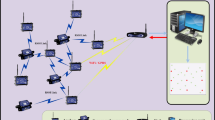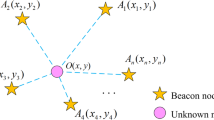Abstract
Wireless sensor networks are a network of sensors interconnected through a wireless medium. Wireless sensor networks are utilized for many array of applications where determining precise location of the sensors are treated to be the crucial task. The prime job of localization is to determine the exact location of sensors placed at particular area as it makes the reference of anchor nodes to determine the location of remaining nodes in the network. Position information of sensor node in an area is useful for routing techniques and some application specific tasks. The localization accuracy is affected due to the estimations in anchor node placements. Localization information is not always easy as it varies with respect to the environment in which the sensors are deployed. Ranging errors occur in hostile environments and accuracy effects as there are signal attenuations in sensors when deployed underwater, underground etc. Efficiency can be enhanced by reducing the error using localization algorithms. Particle swarm optimization is one approach to overcome the localization problem. Results are considered for localization algorithms like Particle swarm optimization, Social group optimization and Velocity adaptation based Particle swarm optimization. The goal of this work is to implement a velocity adaptation based particle swarm optimization for localization method to achieve minimum error. The results reveal that the proposed approach works better for obtaining improved location accuracy.








Similar content being viewed by others
References
Ding C, Yang L, Meng Wu (2017) Localization-free detection of replica node attacks in wireless sensor networks using similarity estimation with group deployment knowledge. Sensors 17(1):160
Alrajeh N, Ali M, Bashir, Shams B (2013) Localization techniques in wireless sensor networks. Int J Distrib Sens Netw 9(6):304628
X Han et al (2017) An RSSI based DV-hop algorithm for wireless sensor networks. In: Communications, computers and signal processing (PACRIM), 2017 IEEE Pacific Rim conference on IEEE
Karim L et al (2017) Localization in terrestrial and underwater sensor-based m2m communication networks: architecture, classification and challenges. Int J Commun Syst 30:4
Kumar M (2014) Localization by decreasing the impact of obstacles in wireless sensor networks (Doctoral dissertation)
Wu W et al (2018) Efficient range-free localization using elliptical distance correction in heterogeneous wireless sensor networks. Int J Distrib Sens Netw 14(1):1550147718756274
Han G et al (2013) Localization algorithms of wireless sensor networks: a survey. Telecommun Syst 52(4):2419–2436
Hemalatha P, Gnanambigai Dr J (2015) A survey on optimization techniques in wireless sensor networks. Int J Adv Res Comput Eng Technol (IJARCET) 4(12)
Gogu A et al (2012) Review of optimization problems in wireless sensor networks. Telecommunications networks-current status and future trends. InTech
Gogu A et al (2011) Optimization problems in wireless sensor networks. Complex, intelligent and software intensive systems (CISIS), 2011 International Conference on IEEE
Adnan M et al (2013) Bio-mimic optimization strategies in wireless sensor networks: a survey. Sensors 14.1:299–345
Tuna G, Gungor VC, Dursun B (2017) Wireless MEMS for smart grids. Wirel MEMS Netw Appl. https://doi.org/10.1016/B978-0-08-100449-4.00011-7
Inbarani H, Hannah AT, Azar Jothi G (2014) Supervised hybrid feature selection based on PSO and rough sets for medical diagnosis. Comput Methods Prog Biomed 113.1: 175–185
Parwekar P, Rodda S, Kalla N (2018) A study of the optimization techniques for wireless sensor networks (WSNs).” Information systems design and intelligent applications. Springer, Singapore, pp 909–915
Cao J (2015) A localization algorithm based on particle swarm optimization and quasi-newton algorithm for wireless sensor networks. J Commun Comput 12:85–90
Tatsumi K, Tetsuzo T (2017) A perturbation based chaotic system exploiting the quasi-newton method for global optimization. Int J Bifur Chaos 27(04):1750047
Pavalarajan S, Krishna Moorthy R (2014) Swarm intelligence based location estimation for wireless sensor network. Appl Mech Mater, vol 573. Trans Tech Publications
Ahmadi H, Viani F, Ridha B (2018) An accurate prediction method for moving target localization and tracking in wireless sensor networks. Ad Hoc Netw 70:14–22
Wang L, Xu Q (2010) GPS-free localization algorithm for wireless sensor networks. Sensors 10(6):5899–5926
Sharma G, Kumar A (2018) Improved DV-hop localization algorithm using teaching learning based optimization for wireless sensor networks. Telecommun Syst 67(2):163–178
Kim Y et al (2018) Localization technique considering position uncertainty of reference nodes in wireless sensor networks. IEEE Sens J 18(3):1324–1332
Pantazis NA, Stefanos A, Nikolidakis Vergados DD (2013) Energy-efficient routing protocols in wireless sensor networks: a survey. IEEE Commun Surv Tutor 15(2):551–591
Xu Y, Zhuang Y, Jing-jing Gu (2015) An improved 3D localization algorithm for the wireless sensor network. Int J Distrib Sens Netw 11(6):315714
Al-Baz A, El-Sayed A (2018) A new algorithm for cluster head selection in LEACH protocol for wireless sensor networks. Int J Commun Syst 31(1):e3407
Sharma G,, Kumar A (2018) Modified energy-efficient range-free localization using teaching–learning-based optimization for wireless sensor networks. IETE J Res 64(1):124–138
Lee KY, Jong-Bae P (2006) Application of particle swarm optimization to economic dispatch problem: advantages and disadvantages. In: Power systems conference and exposition, (2006) PSCE’06. 2006 IEEE PES. IEEE
Sujata B (2017) Energy efficient PEGASIS routing protocol in wireless sensor network. Int Res J Eng Tech 4(7)
Lavanya D, Udgata SK (2011) Swarm intelligence based localization in wireless sensor networks. In: International workshop on multi-disciplinary trends in artificial intelligence. Springer, Berlin, Heidelberg, pp 317–328
Author information
Authors and Affiliations
Corresponding author
Additional information
Publisher’s Note
Springer Nature remains neutral with regard to jurisdictional claims in published maps and institutional affiliations.
Rights and permissions
About this article
Cite this article
Nagireddy, V., Parwekar, P. & Mishra, T.K. Velocity adaptation based PSO for localization in wireless sensor networks. Evol. Intel. 14, 243–251 (2021). https://doi.org/10.1007/s12065-018-0170-4
Received:
Revised:
Accepted:
Published:
Issue Date:
DOI: https://doi.org/10.1007/s12065-018-0170-4




